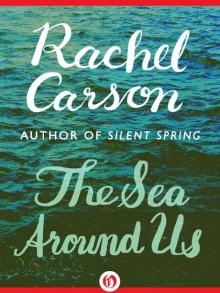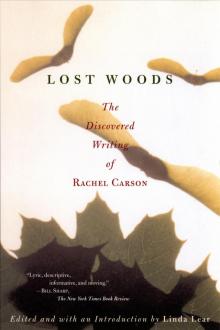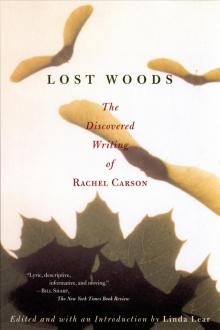- Home
- Rachel Carson
Under the Sea Wind Page 13
Under the Sea Wind Read online
Page 13
From Bittern Pond to the sea is two hundred miles as a fish swims. Thirty miles of the way is by narrow hill streams, seventy miles by a sluggish river crawling over the coastal plain, and a hundred miles through the brackish water of a shallow bay where the sea came in, millions of years ago, and drowned the estuary of a river.
Every spring a number of small creatures come up the grassy spillway and enter Bittern Pond, having made the two-hundred-mile journey from the sea. They are curiously formed, like pieces of slender glass rods shorter than a man’s finger. They are young eels, or elvers, that were born in the deep sea. Some of the eels go higher into the hills, but a few remain in the pond, where they live on crayfish and water beetles and catch frogs and small fishes and grow to adulthood.
Now it was autumn and the end of the year. From the moon’s quarter to its half, rains had fallen, and all the hill streams ran in flood. The water of the two feeder streams of the pond was deep and swift and jostled the rocks of the stream beds as it hurried to the sea. The pond was deeply stirred by the inrush of water, which swept through its weed forests and swirled through its crayfish holes and crept up six inches on the trunks of its bordering willows.
The wind had sprung up at dusk. At first it had been a gentle breeze, stroking the surface of the pond to velvet smoothness. At midnight it had grown to a half gale that set all the rushes to swaying wildly and rattled the dead seed heads of the weeds and plowed deep furrows in the surface waters of the pond. The wind roared down from the hills, over forests of oak and beech and hickory and pine. It blew toward the east, toward the sea two hundred miles away.
Anguilla, the eel, nosed into the swift water that raced toward the overflow from the pond. With her keen senses she savored the strange tastes and smells in the water. They were the bitter tastes and smells of dead and rain-soaked autumn leaves, the tastes of forest moss and lichen and root-held humus. Such was the water that hurried past the eel, on its way to the sea.
Anguilla had entered Bittern Pond as a finger-long elver ten years before. She had lived in the pond through its summers and autumns and winters and springs, hiding in its weed beds by day and prowling through its waters by night, for like all eels she was a lover of darkness. She knew every crayfish burrow that ran in honeycombing furrows through the mudbank under the hill. She knew her way among the swaying, rubbery stems of spatterdock, where frogs sat on the thick leaves; and she knew where to find the spring peepers clinging to grass blades, bubbling shrilly, where in spring the pond overflowed its grassy northern shore. She could find the banks where the water rats ran and squeaked in play or tusseled in anger, so that sometimes they fell with a splash into the water—easy prey for a lurking eel. She knew the soft mud beds deep in the bottom of the pond, where in winter she could lie buried, secure against the cold— for like all eels she was a lover of warmth.
Now it was autumn again, and the water was chilling to the cold rains shed off the hard backbones of the hills. A strange restiveness was growing in Anguilla the eel. For the first time in her adult life, the food hunger was forgotten. In its place was a strange, new hunger, formless and ill-defined. Its dimly perceived object was a place of warmth and darkness— darker than the blackest night over Bittern Pond. She had known such a place once—in the dim beginnings of life, before memory began. She could not know that the way to it lay beyond the pond outlet over which she had clambered ten years before. But many times that night, as the wind and the rain tore at the surface film of the pond, Anguilla was drawn irresistibly toward the outlet over which the water was spilling on its journey to the sea. When the cocks were crowing in the farmyard over the hill, saluting the third hour of the new day, Anguilla slipped into the channel spilling down to the stream below and followed the moving water.
Even in flood, the hill stream was shallow, and its voice was the noisy voice of a young stream, full of gurglings and tricklings and the sound of water striking stone and of stone rubbing against stone. Anguilla followed the stream, feeling her way by the changing pressure of the swift water currents. She was a creature of night and darkness, and so the black water path neither confused nor frightened her.
In five miles the stream dropped a hundred feet over a rough and boulder-strewn bed. At the end of the fifth mile it slipped between two hills, following along a deep gap made by another and larger stream years before. The hills were clothed with oak and beech and hickory, and the stream ran under their interlacing branches.
At daybreak Anguilla came to a bright, shallow riffle where the stream chattered sharply over gravel and small rubble. The water moved with a sudden acceleration, draining swiftly toward the brink of a ten-foot fall where it spilled over a sheer rock face into a basin below. The rush of water carried Anguilla with it, down the steep, thin slant of white water and into the pool. The basin was deep and still and cool, having been rounded out of the rock by centuries of falling water. Dark water mosses grew on its sides and stoneworts were rooted in its silt, thriving on the lime which they took from the stones and incorporated in their round, brittle stems. Anguilla hid among the stoneworts of the pool, seeking a shelter from light and sun, for now the bright shallows of the stream repelled her.
Before she had lain in the pool for an hour another eel came over the falls and sought the darkness of the deep leaf beds. The second eel had come from higher up in the hills, and her body was lacerated in many places from the rocks of the thin upland streams she had descended. The newcomer was a larger and more powerful eel than Anguilla, for she had spent two more years in fresh water before coming to maturity.
Anguilla, who had been the largest eel in Bittern Pond for more than a year, dived down through the stoneworts at sight of the strange eel. Her passage swayed the stiff, limy stems of the chara and disturbed three water boatmen that were clinging to the chara stems, each holding its position by the grip of a jointed leg, set with rows of bristles. The insects were browsing on the film of desmids and diatoms that coated the stems of the stoneworts. The boatmen were clothed in glistening blankets of air which they had carried down with them when they dived through the surface film, and when the passing of the eel dislodged them from their quiet anchorage they rose like air bubbles, for they were lighter than water.
An insect with a body like a fragment of twig supported by six jointed legs was walking over the floating leaves and skating on the surface of the water, on which it moved as on strong silk. Its feet depressed the film into six dimples, but did not break it, so light was its body. The insect’s name meant “a marsh treader,” for its kind often lived in the deep sphagnum moss of bogs. The marsh treader was foraging, watching for creatures like mosquito larvae or small crustaceans to move up to the surface from the pool below. When one of the water boatmen suddenly broke through the film at the feet of the marsh treader, the twiglike insect speared it with the sharp stilettos projecting beyond its mouth and sucked the little body dry.
When Anguilla felt the strange eel pushing into the thick mat of dead leaves on the floor of the pool, she moved back into the dark recess behind the waterfall. Above her the steep face of the rock was green with the soft fronds of mosses that grew where their leaves escaped the flow of water, yet were always wet with fine spray from the falls. In spring the midges came there to lay their eggs, spinning them in thin, white skeins on the wet rocks. Later when the eggs hatched and the gauzy-winged insects began to emerge from the falls in swarms, they were watched for by bright-eyed little birds who sat on overhanging branches and darted open-mouthed into the clouds of midges. Now the midges were gone, but other small animals lived in the green, water-soaked thickets of the moss. They were the larvae of beetles and soldier flies and crane flies. They were smooth-bodied creatures, lacking the grappling hooks and suckers and the flattened, stream-molded bodies that enabled their relatives to live in the swift currents draining to the brink of the falls overhead or a dozen feet away where the pool spilled its water into the stream bed. Although they lived only a few inches from
the veil of water that dropped sheer to the pool, they knew nothing of swift water and its dangers; their peaceful world was of water seeping slow through green forests of moss.
The beginning of the great leaf fall had come with the rains of the past fortnight. Throughout the day, from the roof of the forest to its floor, there was a continuous downdrift of leaves. The leaves fell so silently that the rustle of their settling to the ground was no louder than the thin scratching of the feet of mice and moles moving through their passages in the leaf mold.
All day flights of broad-winged hawks passed down along the ridges of the hills, going south. They moved with scarcely a beat of their outspread wings, for they were riding on the updrafts of air made as the west wind struck the hills and leaped upward to pass over them. The hawks were fall migrants from Canada that had followed down along the Appalachians for the sake of the air currents that made the flight easier.
At dusk, as the owls began to hoot in the woods, Anguilla left the pool and traveled downstream alone. Soon the stream flowed through rolling farm country. Twice during the night it dropped over small milldams that were white in the thin moonlight. In the stretch below the second dam, Anguilla lay for a time under an overhanging bank, where the swift currents were undercutting the heavy, grassy turf. The sharp hiss of the water over the slanting boards of the dam had frightened her. As she lay under the bank the eel that had rested with her in the pool of the waterfall came over the milldam and passed on downstream. Anguilla followed, letting the current take her bumping and jolting over the shallow riffles and gliding swiftly through the deeper stretches. Often she was aware of dark forms moving in the water near her. They were other eels, come from many of the upland feeder creeks of the main stream. Like Anguilla, the other long, slender fishes yielded to the hurrying water and let the currents speed their passage. All of the migrants were roe eels, for only the females ascend far into the fresh-water streams, beyond all reminders of the sea.
The eels were almost the only creatures that were moving in the stream that night. Once, in a copse of beech, the stream made a sharp bend and scoured out a deeper bed. As Anguilla swam into this rounded basin, several frogs dived down from the soft mud bank where they had been sitting half out of the water and hid on the bottom close to the bole of a fallen tree. The frogs had been startled by the approach of a furred animal that left prints like those of human feet in the soft mud and whose small black mask and black-ringed tail showed in the faint moonlight. The raccoon lived in a hole high up in one of the beeches near by and often caught frogs and crayfish in the stream. He was not disconcerted by the series of splashes that greeted his approach, for he knew where the foolish frogs would hide. He walked out on the fallen tree and lay down flat on its trunk. He took a firm grip on its bark with the claws of his hind feet and left forepaw. The right paw he dipped into the water, reaching down as far as he could and exploring with busy, sensitive fingers the leaves and mud under the trunk. The frogs tried to burrow deeper into the litter of leaves and sticks and other stream debris. The patient fingers felt into every hole and crevice, pushed away leaves and probed the mud. Soon the coon felt a small, firm body beneath his fingers—felt the sudden movement as the frog tried to escape. The coon’s grip tightened and he drew the frog quickly up onto the log. There he killed it, washed it carefully by dipping it into the stream, and ate it. As he was finishing his meal, three small black masks moved into a patch of moonlight at the edge of the stream. They belonged to the coon’s mate and their two cubs, who had come down the tree to prowl for their night’s food.
From force of habit, the eel thrust her snout inquisitively into the leaf litter under the log, adding to the terror of the frogs, but she did not molest them as she would have done in the pond, for hunger was forgotten in the stronger instinct that made her a part of the moving stream. When Anguilla slipped into the central current of water that swept past the end of the log, the two young coons and their mother had walked out onto the trunk and four black-masked faces were peering into the water, preparing to fish the pool for frogs.
By morning the stream had broadened and deepened. Now it fell silent and mirrored an open woods of sycamore, oak, and dogwood. Passing through the woods, it carried a freight of brightly colored leaves— bright-red, crackling leaves from the oaks, mottled green and yellow leaves from the sycamores, dull-red, leathery leaves from the dogwoods. In the great wind the dogwoods had lost their leaves, but they held their scarlet berries. Yesterday robins had gathered in flocks in the dogwoods, eating the berries; today the robins were gone south and in their place flurries of starlings swept from tree to tree, chattering and rattling and whistling to one another as they stripped the branches of berries. The starlings were in bright new fall plumage, with every breast feather spear-tipped with white.
Anguilla came to a shallow pool formed when an oak had been uprooted in a great autumn storm ten years before and had fallen across the stream. Oak dam and pool were new in the stream since Anguilla had ascended it as an elver in the spring of that year. Now a great mat of weeds, silt, sticks, dead branches, and other debris was packed around the massive trunk, plastering all the crevices, so that the water was backed up into a pool two feet deep. During the period of the full moon the eels lay in the oak-dam pool, fearing to travel in the moon-white water of the stream almost as much as they feared the sunlight.
In the mud of the pool were many burrowing, wormlike larvae—the young of lamprey eels. They were not true eels, but fishlike creatures whose skeleton was gristle instead of bone, with round, tooth-studded mouths that were always open because there were no jaws. Some of the young lampreys had hatched from eggs spawned in the pool as much as four years before and had spent most of their life buried in the mud flats of the shallow stream, blind and toothless. These older larvae, grown nearly twice the length of a man’s finger, had this fall been transformed into the adult shape, and for the first time they had eyes to see the water world in which they lived. Now, like the true eels, they felt in the gentle flow of water to the sea something that urged them to follow, to descend to salt water for an interval of sea life. There they would prey semiparasitically on cod, haddock, mackerel, salmon, and many other fishes and in time would return to the river, like their parents, to spawn and die. A few of the young lampreys slipped away over the log dam every day, and on a cloudy night, when rain had fallen and white mist lay in the stream valley, the eels followed.
The next night the eels came to a place where the stream diverged around an island grown thickly with willows. The eels followed the south channel around the island, where there were broad mud flats. The island had been formed over centuries of time as the stream had dropped part of its silt load before it joined the main river. Grass seeds had taken root; seeds of trees had been brought by the water and by birds; willow shoots had sprung from broken twigs and branches carried down in flood waters; an island had been born.
The water of the main river was gray with approaching day when the eels entered it. The river channel was twelve feet deep and its water was turbid because of the inpouring of many tributary streams swollen with autumn rains. The eels did not fear the gloomy channel water by day as they had feared the bright shallows of the hill streams, and so this day they did not rest but pushed on downstream. There were many other eels in the river—migrants from other tributaries. With the increase in their numbers the excitement of the eels grew, and as the days passed they rested less often, pressing on downstream with fevered haste.
As the river widened and deepened, a strange taste came into the water. It was a slightly bitter taste, and at certain hours of the day and night it grew stronger in the water that the eels drew into their mouths and passed over their gills. With the bitter taste came unfamiliar movements of the water—a period of pressure against the downflow of the river currents followed by slow release and then swift acceleration of the current.
Now groups of slender posts stood at intervals in the river, marking out funnel
shapes from which straight rows of posts ran slanting toward the shore. Blackened netting, coated with slimy algae, was run from post to post and showed several feet above the water. Gulls were often sitting on the pound nets, waiting for men to come and fish the nets so that they could pick up any fish that might be thrown away or lost. The posts were coated with barnacles and with small oysters, for now there was enough salt in the water for these shellfish to grow.
Sometimes the sandspits of the river were dotted with small shore birds standing at rest or probing at the water’s edge for snails, small shrimps, worms, or other food. The shore birds were of the sea’s edge, and their presence in numbers hinted of the nearness of the sea.
The strange, bitter taste grew in the water and the pulse of the tides beat stronger. On one of the ebb tides a group of small eels—none more than two feet long—came out of a brackish-water marsh and joined the migrants from the hill streams. They were males, who had never ascended the rivers but had remained within the zone of tides and brackish water.
In all of the migrants striking changes in appearance were taking place. Gradually the river garb of olive brown was changing to a glistening black, with underparts of silver. These were the colors worn only by mature eels about to undertake a far sea journey. Their bodies were firm and rounded with fat—stored energy that would be needed before the journey’s end. Already in many of the migrants the snouts were becoming higher and more compressed, as though from some sharpening of the sense of smell. Their eyes were enlarged to twice their normal size, perhaps in preparation for a descent along darkening sea lanes.
Where the river broadened out to its estuary, it flowed past a high clay cliff on its southern bank. Buried in the cliff were thousands of teeth of ancient sharks, vertebrae of whales, and shells of mollusks that had been dead when the first eels had come in from the sea, eons ago. The teeth, bones, and shells were relics of the time when a warm sea had overlain all the coastal plain and the hard remains of its creatures had settled down into its bottom oozes. Buried millions of years in darkness, they were washed out of the clay by every storm to lie exposed, warmed by sunshine and bathed by rain.

 Silent Spring
Silent Spring Under the Sea Wind
Under the Sea Wind The Edge of the Sea
The Edge of the Sea The Sea Around Us
The Sea Around Us Lost Woods: The Discovered Writing of Rachel Carson
Lost Woods: The Discovered Writing of Rachel Carson Lost Woods
Lost Woods